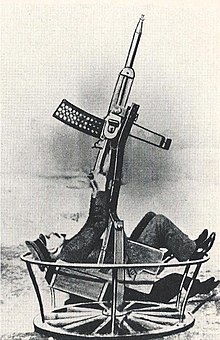Air defense

Under air defense (abbreviated flab , obsolete air defense ) refers to military action to defend its own airspace against the intrusion of hostile aircraft and other missiles ( cruise missiles , drones , ballistic missiles ).
The term anti-aircraft defense of all troops (on land) describes in the parlance of the German armed forces the combating of air targets for self-defense by all troops that are not specialized for this purpose. For this purpose, all weapons, including small arms and anti-tank weapons (for fighting helicopters), are used to defend against enemy aircraft. Repeater shotguns with shot ammunition can also be used against the lowest-flying small drones.
For fire regulation see also fire permit .
basis
With the weapon systems used for air defense, a distinction is made between anti-aircraft cannons and anti-aircraft missiles (surface-to-air missiles). In the Bundeswehr these systems are called FlaK and FlaRak for short . While targets used to be located by sight or sound, today the primary sensor used is radar . Short-range systems also use infrared or other optical sensors to locate enemy aircraft. Anti-aircraft guns were supported by anti-aircraft searchlights during night attacks .
Air defense systems can be installed permanently or mobile on vehicles, tanks or ships . There are also anti-aircraft missiles that can be operated by one man, so-called MANPADS such as the American Stinger or the Russian Strela .
Countermeasures

Successful air defense puts the advantage of the attacker's air superiority into perspective . Therefore, in parallel to the development of air defense from the Second World War , self-protection devices for aircraft against the newly invented radar were developed. The German chaff strips and the British Chaff or Windows were quite primitive initial developments . Since the mid-1970s, efforts have been made to use stealth technology to build stealth planes that are more difficult for enemy radar to detect.
A special form of passive air defense was the construction of dummy systems . During the Second World War z. B. About a third of the 1.5 square kilometer built-up site of the Krupp cast steel factory, mainly facilities in the outer area, completely destroyed, another third partially. In order to avert and deceive Allied air raids, a mock-up of the cast steel factory was created on the Rottberg near Velbert from 1941 , the so-called Krupp night glow system . Initially, it attracted a few attacks, but lost its effectiveness from 1943 onwards as the aviators were better able to orient themselves, including the introduction of radar . During the first attack on the actual cast steel factory in March 1943, the Allies dropped 30,000 bombs, which also bombed surrounding housing estates and thus civilians.
Air defense itself is severely endangered by air attacks . In particular, radar-based systems can be disrupted by transmitters, localized and finally destroyed with special missiles. The rocket uses the energy emitted by the radar transmitter as a beacon and flies to its source, i.e. the radar antenna. Such inserts are suppression of enemy air defense ( Engl. Suppression of Enemy Air Defenses called (SEAD)). For this task, the German and Italian air forces use the ECR-Tornado weapon system, which is a modified version of the Tornado fighter-bomber with HARM rockets . The US Air Force fights air defense with the wild weasel tactic, among other things .
Clever tactics can reduce the risk of localization and destruction of air defense systems. For this purpose, the radar stations are networked and the actual radar system is only operated when it is absolutely necessary.
Organization and assignment
Germany
In the Bundeswehr, the air force is responsible for air defense . In the army, there were up to the March 12, 2012 army air defense troops . It fought the air enemy primarily in the low and medium altitude range and protected all troops whose facilities and systems were in their area of operation.
The Luftwaffe anti-aircraft missile squadron 1 is responsible for combating enemy aircraft at high altitudes . In the navy , the F 124 class frigates are mainly used for air defense / air defense . Most of the other ships in the Navy also have anti-aircraft weapons.
For air defense of all troops on land used machine guns (with anti-aircraft sight) and (onboard) machine guns and anti-tank missile as the PARS 3 , in exceptional cases, assault rifles . Hand-held anti-tank weapons can be used to fight slow aircraft such as helicopters, especially from elevated firing positions in local and urban combat.
Austria
In the Austrian Armed Forces , the air defense takes over the task of air defense and is a synonym.
Switzerland

In the Swiss Army , as part of the Swiss Air Force, this type of service is referred to as anti-aircraft troops and is a synonym.
United States
In the US armed forces , ground air defense forces are a branch of the US Army .
See also
- Flak tower
- List of surface-to-air missiles
- Air war
- Military aviation
- Close-range protection system MANTIS
- RIM-116 Rolling Airframe Missile
- Tracker (radar) , short-range radar
literature
- Hartmut Oberfell: Chronicle of the air defense and anti-aircraft missile troops of the Air Force. 1991.
- Otto Wilhelm von Renz: German air defense in the 20th century. ES Mittler & Sohn, 1960.
- Raimo Vehviläinen, Ahti Lappi, Markku Palokangas: Independent Finland air defense cannons 1917–2000. Finnish War Museum , 1/2005.
- Wolfgang Zecha, Hans Hirnschall: 200 years of air defense in Austria 1794–1994. Publishing bookstore Stöhr, Vienna 1994.
- Warren J. Boord, et al .: Air and missile defense systems engineering. CRC Press, Boca Raton, 2016, ISBN 978-1-439-80670-8 .
Web links
- Air defense systems of the Air Force
- Bundeswehr Classix: Targets in the Sky (1976) ( YouTube video)
- Homepage of the Finnish Air Defense Museum Ilmatorjuntamuseo (English)


